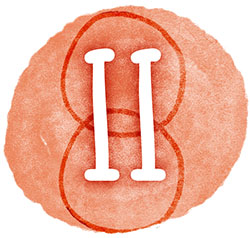Balance
Duality
All of life is built on dualities—light and dark, activity and rest, joy and sorrow. These contrasts are not just opposites; they are interconnected forces that create harmony.

Core-concepts
Section 2
Balance is found when we embrace these contradictions and understand that life isn’t about choosing one side but recognizing the value of both. True balance comes from navigating between extremes, appreciating that each side has its time and place in our journey.
To be truly whole, we must embrace the full range of our emotions—welcoming both joy and sorrow, comfort and discomfort, anxiety and calmness. By observing the natural imbalances within ourselves and the world, we unlock a deeper understanding and strike a powerful balance that brings fulfillment.
Life, by its very nature, may lean towards imbalance, but it’s within our power to create a sustainable sense of equilibrium by building routines that nourish all our essential needs.
Duality is a constant force in our lives, offering us choices, dilemmas, and challenges. Everything is a contradiction. How we navigate these dualities shapes our personal growth, guides our ethical decisions, and deepens our understanding of the complex world we live in. By embracing this journey, we empower ourselves to live with purpose, passion, and clarity.
Reflect on these dualities and consider how you’re already achieving balance and where you might find opportunities to create even more harmony in your life. It’s easy to believe we are only one thing—like thinking, " I prefer solitude", even the most introspective among us need social interaction to feel truly fulfilled and whole.
Lifestyle Duality
 Reflect
Reflect
- What are some dualities I feel I'm balancing well?
- Which ones could use more balance in my daily life?
- Work-Life Balance: Managing the demands of career and personal life, balancing time for work, leisure, and relationships.
- Healthy vs. Indulgent Lifestyle: Balancing health-conscious choices with moments of indulgence, recognizing that both nourish in different ways.
- Simplicity vs. Complexity: Choosing between a minimalistic lifestyle and a more complex, high-paced one, depending on personal values and life stages.
- Active vs. Sedentary Lifestyle: Incorporating physical activity into daily life or accepting periods of rest and inactivity.
- Social Interaction vs. Solitude: Balancing the need for social engagement with time for solitude and personal reflection.
- Frugality vs. Extravagance: Managing finances by balancing frugality with moments of indulgence or luxury spending.
- Mindful Consumption vs. Consumerism: Navigating between sustainable, mindful consumption and the pull of consumerism.
- Routine vs. Spontaneity: Finding balance between structured routines and the freedom to embrace spontaneity.
- Introversion vs. Extroversion: Understanding and balancing personal needs for social interaction with time for recharging alone.
- Digital Detox vs. Digital Dependence: Managing screen time and technology use with intentional breaks for digital detox and mindfulness.
- Minimalism vs. Materialism: Balancing the desire for fewer possessions with the inclination toward material accumulation.
- Environmental Stewardship vs. Environmental Impact: Striving for eco-friendly practices while acknowledging personal and societal environmental footprints.
- Planning vs. Spontaneity: Striking a balance between planning for the future and embracing the unpredictability of life.
- Self-Improvement vs. Self-Acceptance: Pursuing growth while also practicing self-compassion and acceptance.
- Moderation vs. Excess: Finding a middle ground between moderate consumption and indulging in excess, whether in diet, habits, or lifestyle.
- Community Involvement vs. Individualism: Engaging in collective activities for the greater good while honoring personal independence and goals.
- Financial Security vs. Financial Risk: Balancing the need for financial stability with the willingness to take calculated risks for potential growth.
- Tradition vs. Innovation: Respecting traditions while embracing change and innovation in various aspects of life
Gender Duality
Female vs. Male
Masculine and feminine energies are a framework that helps us understand the different aspects of who we are. These energies aren't about gender but are qualities we all carry—archetypes that show up in how we navigate life.
We all carry both masculine and feminine energies, and astrology provides a unique lens to understand how these energies manifest within us. By looking at your natal chart, you can see which energies are more prominent—some people have an even split 5f/5m, while others may lean more toward one side 7f/3m. For example, someone with Mars and Aries strong in their chart may express more masculine traits like assertiveness and action, while someone with Venus and Cancer energy might naturally embody more feminine traits such as nurturing and intuition. Recognizing this balance helps us tap into the right energy when needed, whether it’s to take decisive action or approach a situation with empathy.
But balance isn’t about trying to achieve a perfect 50/50 split. It’s about recognizing when one energy serves you better in a certain situation and letting that guide you. Embrace the ebb and flow of these energies, and let them support you in creating a more balanced, fulfilling life.
 Reflect
Reflect
- How do I embrace both energies?
- When does masculine energy and feminine energy serve me better.
Masculine Energy
Qualities: Masculine energy is often associated with qualities such as strength, assertiveness, logic, analytical thinking, independence, action, and focus on achievement and goals.
Archetypes: It is linked to archetypes like the Warrior, the Provider, and the Hero.
Expression: People with a dominant masculine energy tend to be task-oriented, goal-driven, and focused on problem-solving and taking action.
Feminine Energy
Qualities: Feminine energy is associated with qualities such as nurturing, intuition, receptivity, compassion, empathy, emotional awareness, and creativity.
Archetypes: It is linked to archetypes like the Nurturer, the Caregiver, and the Muse.
Expression: Individuals with dominant feminine energy may be more relationship-focused, emotionally expressive, and attuned to the needs of others.
Spiritual Duality
 Reflect
Reflect
- How can acknowledging life’s fragility influence the choices I make today?
- What changes can I implement to live more intentionally?
Life vs. Death
Life and death are like two sides of the same coin—completely different, yet inseparable. Embracing this duality means understanding that death is inevitable but not letting it overshadow how we live. It’s about cherishing every moment and making the most of our time here.
When we’re aware of both life’s fragility and its endless possibilities, we tend to live with more purpose and intention. Every moment becomes an opportunity to be present, grateful, and intentional. This balance between acknowledging the finite and embracing the infinite is what makes life so rich and meaningful, pushing us to dive deeper into what truly matters.
Emotional Duality
Emotions often exist on a spectrum, reflecting the duality of positive and negative experiences that are fundamental to our lives. Rather than labeling emotions as ‘good’ or ‘bad,’ it’s crucial to recognize their roles in shaping our experiences and contributing to our growth. This balanced perspective allows us to see both uplifting and challenging emotions as essential parts of personal development and resilience.
By embracing the full range of emotions, we honor the complexity of the human experience. Both sides of the emotional spectrum are necessary for a complete and meaningful life. In a world where much of life is structured, sitting with our emotions—whether they bring joy or discomfort—allows us to experience the fluidity and richness of life.
 Question
Question
- What emotions are most present in my life right now?
- How can I embrace the full range of my emotions to support my personal growth?
LOVE VS. FEAR
For simplicity, emotions that bring joy, love, light, and happiness can be categorized as love, while those that bring darkness or discomfort can be categorized as fear. Both love and fear are vital forces in our lives. From fear comes great strength and power, and from love comes great courage and compassion. Neither is superior; both are essential in their own right.
- Happiness vs. Sadness: Joy and contentment contrasted with sorrow and unhappiness.
- Love vs. Hate: Affection and care versus anger and hostility.
- Confidence vs. Insecurity: Self-assuredness versus self-doubt.
- Calmness vs. Anxiety: Peace and tranquility versus unease and worry.
- Courage vs. Fear: Facing challenges versus feeling apprehensive.
- Excitement vs. Boredom: Enthusiasm and interest versus monotony.
- Empathy vs. Apathy: Understanding others versus indifference.
- Optimism vs. Pessimism: A positive outlook versus a negative perspective.
- Acceptance vs. Denial: Embracing reality versus avoiding it.
- Gratitude vs. Ingratitude: Thankfulness versus taking things for granted.
- Forgiveness vs. Resentment: Letting go of bitterness versus holding grudges.
- Compassion vs. Indifference: Kindness versus apathy.
- Contentment vs. Envy: Satisfaction with life versus jealousy.
- Patience vs. Impatience: Calmness in waiting versus restlessness.
- Hope vs. Despair: Optimism for the future versus hopelessness.
- Guilt vs. Innocence: Responsibility for wrongdoing versus lack of it.
- Elation vs. Melancholy: Intense happiness versus deep sadness.
- Vulnerability vs. Strength: Embracing openness versus emotional walls.
- Empowerment vs. Powerlessness: Feeling capable versus helpless.
- Self-Love vs. Self-Criticism: Practicing self-compassion versus self-doubt.
In the dance between structure and emotion, the ability to sit with and appreciate all our feelings—whether they bring light or shadow—is where we find true balance. This fluidity is essential in living a life that is not only structured but also deeply connected and meaningful.

Resources
 Read
Read
- "Everything is a Contradiction"-Maya Low - Medium
- Duality Quotes -Spread Great Ideas
- "How to Leverage The Paradox of Duality to Add More Meaning and Efficiency to Life"Eze Onukwube - Medium
- "The Power of Being Mindful of Life's Duality"-Working on Calm
 Quotes
Quotes
“All being, it seemed, was built on opposites, on division. Man or woman, vagabond or citizen, lover or thinker — no breath could both be in and out, none could be man and wife, free and yet orderly, knowing the urge of life and the joy of intellect. Always the one paid for the other, though each was equally precious and essential.”
“But there is no energy unless there is a tension of opposites; hence it is necessary to discover the opposite to the attitude of the conscious mind.”
 Watch
Watch
Inspiration
![]()





 Reflect
Reflect Read
Read Quotes
Quotes Watch
Watch